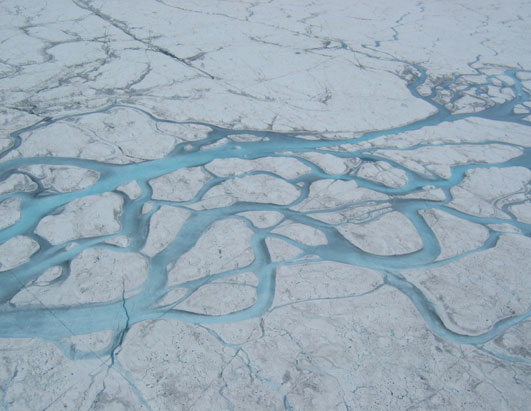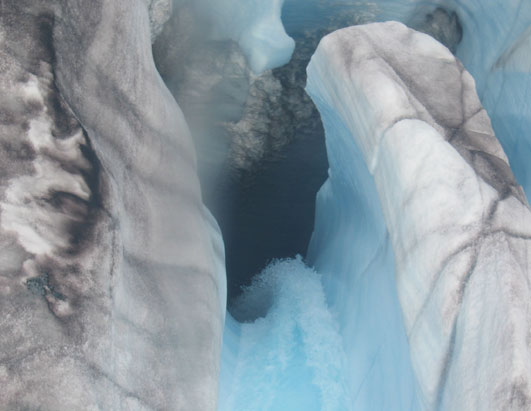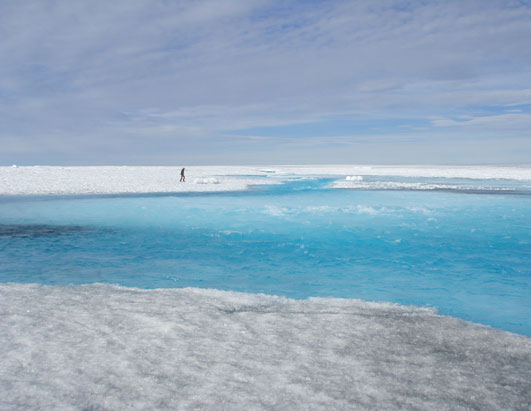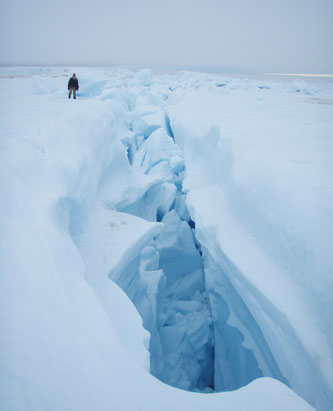Greenland is the world's largest island. Formerly a province of Denmark, it gained the status of an autonomous Danish dependent territory with limited self-government as well as its own parliament in 1979.

The climate in Greenland is extremely harsh. More than 80% of the island is covered by an ice cap which is 4km thick in places.
Preliminary results suggest that Greenland's ice cover has shrunk to a record low this summer, 2007. Dr Bob Corell, chairman of the Arctic Climate Impact Assessment, told a symposium of scientists and religious leaders inGreenland, which finished this week, that the acceleration of the Arctic ice melt was now "massive".
Here are few pictures & description on Greedland Melting.

Greenland's Ice Sheet is undergoing massive changes, including melted lakes on the surface and holes in the overflow channel leading to a moulin, a crevasse through which water enters a glacier bed from the surface.

Scientists discover large holes on the surface of Greenland's Ice Sheet, which can shift vertically and horizontally as a result.

Melted ice can be seen on the surface of the ice sheet.

Several fractures have appeared on the ice sheet. A large surface glacial lake can drain in less than two hours, pouring water down through a 980-meter-thick ice sheet at an average rate exceeding that of the flow at Niagara Falls.

A large channel has been carved out by melted water on the ice sheet's surface.

Meltwater, or the melting of snow or ice, rushes across the surface of the ice sheet, filling up a lake.

Scientist Ian Joughin observes a large fracture running through the lake basin in Greenland. Newly formed blocks of ice are more prevalent on the surface of the ice sheet.

The climate in Greenland is extremely harsh. More than 80% of the island is covered by an ice cap which is 4km thick in places.
Preliminary results suggest that Greenland's ice cover has shrunk to a record low this summer, 2007. Dr Bob Corell, chairman of the Arctic Climate Impact Assessment, told a symposium of scientists and religious leaders inGreenland, which finished this week, that the acceleration of the Arctic ice melt was now "massive".
Here are few pictures & description on Greedland Melting.

Greenland's Ice Sheet is undergoing massive changes, including melted lakes on the surface and holes in the overflow channel leading to a moulin, a crevasse through which water enters a glacier bed from the surface.

Scientists discover large holes on the surface of Greenland's Ice Sheet, which can shift vertically and horizontally as a result.

Melted ice can be seen on the surface of the ice sheet.

Several fractures have appeared on the ice sheet. A large surface glacial lake can drain in less than two hours, pouring water down through a 980-meter-thick ice sheet at an average rate exceeding that of the flow at Niagara Falls.

A large channel has been carved out by melted water on the ice sheet's surface.

Meltwater, or the melting of snow or ice, rushes across the surface of the ice sheet, filling up a lake.

Scientist Ian Joughin observes a large fracture running through the lake basin in Greenland. Newly formed blocks of ice are more prevalent on the surface of the ice sheet.
0 comments:
Post a Comment